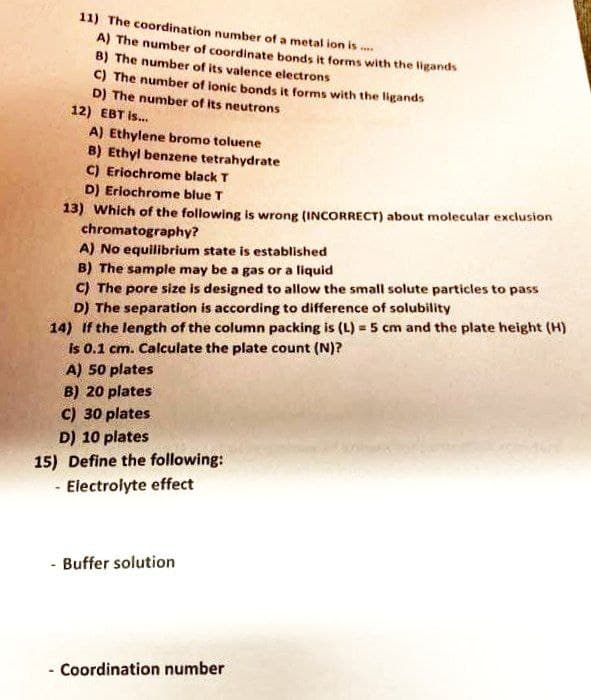11) The coordination number of a metal ion is.... A) The number of coordinate bonds it forms with the ligands B) The number of its valence electrons C) The number of ionic bonds it forms with the ligands D) The number of its neutrons 121 FDM
11) The coordination number of a metal ion is.... A) The number of coordinate bonds it forms with the ligands B) The number of its valence electrons C) The number of ionic bonds it forms with the ligands D) The number of its neutrons 121 FDM
Chemistry
10th Edition
ISBN:9781305957404
Author:Steven S. Zumdahl, Susan A. Zumdahl, Donald J. DeCoste
Publisher:Steven S. Zumdahl, Susan A. Zumdahl, Donald J. DeCoste
Chapter21: Transition Metals And Coordination Chemistry
Section: Chapter Questions
Problem 108IP: a. In the absorption spectrum of the complex ion Cr(NCS)63, there is a band corresponding to the...
Related questions
Question

Transcribed Image Text:11) The coordination number of a metal ion is....
A) The number of coordinate bonds it forms with the ligands
B) The number of its valence electrons
C) The number of ionic bonds it forms with the ligands
D) The number of its neutrons
A) Ethylene bromo toluene
B) Ethyl benzene tetrahydrate
C) Eriochrome black T
D) Eriochrome blue T
13) Which of the following is wrong (INCORRECT) about molecular exclusion
chromatography?
A) No equilibrium state is established
B) The sample may be a gas or a liquid
C) The pore size is designed to allow the small solute particles to pass
D) The separation is according to difference of solubility
14) If the length of the column packing is (L) = 5 cm and the plate height (H)
is 0.1 cm. Calculate the plate count (N)?
A) 50 plates
B) 20 plates
C) 30 plates
D) 10 plates
15) Define the following:
- Electrolyte effect
- Buffer solution
- Coordination number
12) EBT is...
Expert Solution
This question has been solved!
Explore an expertly crafted, step-by-step solution for a thorough understanding of key concepts.
Step by step
Solved in 2 steps

Knowledge Booster
Learn more about
Need a deep-dive on the concept behind this application? Look no further. Learn more about this topic, chemistry and related others by exploring similar questions and additional content below.Recommended textbooks for you

Chemistry
Chemistry
ISBN:
9781305957404
Author:
Steven S. Zumdahl, Susan A. Zumdahl, Donald J. DeCoste
Publisher:
Cengage Learning

Chemistry: An Atoms First Approach
Chemistry
ISBN:
9781305079243
Author:
Steven S. Zumdahl, Susan A. Zumdahl
Publisher:
Cengage Learning


Chemistry
Chemistry
ISBN:
9781305957404
Author:
Steven S. Zumdahl, Susan A. Zumdahl, Donald J. DeCoste
Publisher:
Cengage Learning

Chemistry: An Atoms First Approach
Chemistry
ISBN:
9781305079243
Author:
Steven S. Zumdahl, Susan A. Zumdahl
Publisher:
Cengage Learning


Principles of Modern Chemistry
Chemistry
ISBN:
9781305079113
Author:
David W. Oxtoby, H. Pat Gillis, Laurie J. Butler
Publisher:
Cengage Learning

Chemistry by OpenStax (2015-05-04)
Chemistry
ISBN:
9781938168390
Author:
Klaus Theopold, Richard H Langley, Paul Flowers, William R. Robinson, Mark Blaser
Publisher:
OpenStax

Chemistry: Principles and Practice
Chemistry
ISBN:
9780534420123
Author:
Daniel L. Reger, Scott R. Goode, David W. Ball, Edward Mercer
Publisher:
Cengage Learning